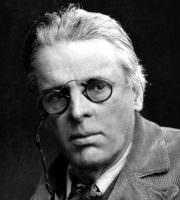About William Butler Yeats
William Butler Yeats was a famous Irish poet, writer and playwright, born June 13, 1865 in Sandymount, Ireland and died on January 28, 1939 in Roquebrune-Cap-Martin, France. Yeats is widely regarded as one of the 20th century’s greatest writers. He spearheaded the Irish literary revival of the early 20th century, and in 1904 he co-founded the Abbey Theatre in Dublin with Lady Gregory and his friend Edward Martyn. He served as the company’s chief executive during its first years. A prominent member of Ireland’s literary community, Yeats later served as a two-time Irish Senator. In 1923, he was awarded a Nobel Prize in Literature for what the Nobel Committee described as inspired poetry, which in a highly artistic form gives expression to the spirit of a whole nation.In October 1881, Yeats entered Erasmus Smith High School in Dublin. It was during this period that he began to write poetry, and in 1885 his first poems, together with an essay titled The Poetry of Sir Samuel Ferguson, were published in the Dublin University Review. A contemporary of Wilde, he oscillated for a long time between decadent London at the end of the 19th century and Ireland in full swing for independence. His first poems are characterized by a marked use of symbols taken from various traditions (Irish, Kabbalah, Catholicism, Greek and Roman). Yeats' poetry of this period is largely steeped in Irish myth and folklore but also in the diction of pre-Raphaelite verse. It was Percy Bysshe Shelley who then exercised the greatest influence on him and it would remain so throughout his life. This youthful style, marked by the imaginary and the spiritual, gradually gave way to the real, following on from his meeting with Maud Gonne, whose influence on Yeats was considerable throughout the years.
His first works aspired to a romantic richness, which is traced in his collection published in 1893 Celtic Twilight, but in his forties, inspired by his relationship with modernist poets such as Ezra Pound and in connection with his involvement in Irish nationalism, he evolved towards an uncompromising modern style. Towards the end of his life, he turned to the language of the ordinary people, against a certain contemporary elitism, seeking a poetic writing that was as direct and natural as conversation. His poems stand out: The Wild Swans at Coole in 1917, The Tower in 1928 (so named after "Thoor Ballylee") and finally The Winding Stair in 1929. In these later poems, Yeats' language becomes increasingly forceful; the images become more concrete and the symbolism more comprehensive. While in his early lyrical work the strong attraction that the ghost light of the Celtic twilight exerted on him and initially gave his poems an unrealistic mood of romantic sadness and heroic greatness can be felt, in his later work he overcomes this late romantic rhetoric of longing of his first creative phase. Nevertheless, the newly gained closeness to life in no way restricts his poetic and pictorial imagination. Increasingly, the myth opens up to him as a symbolic expression of the events of his time. Linked to this is the transition from Irish to Greek myths, in which Yeats sees his conception of the cyclical recurrence of everything that happened more clearly as an example. He set out his philosophy in the prose work A Vision (1925, revised 1937 edition), which he co-wrote with his wife. In his 70s, he continued to amaze and delight audiences with his poetry collections New Poems and Last Poems and Two Plays.
Below are listed some of his most iconic poems that can give you an overview of his different themes and topics.
Browse all poems and texts published on William Butler Yeats









